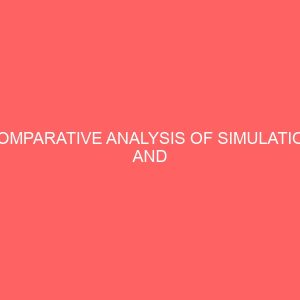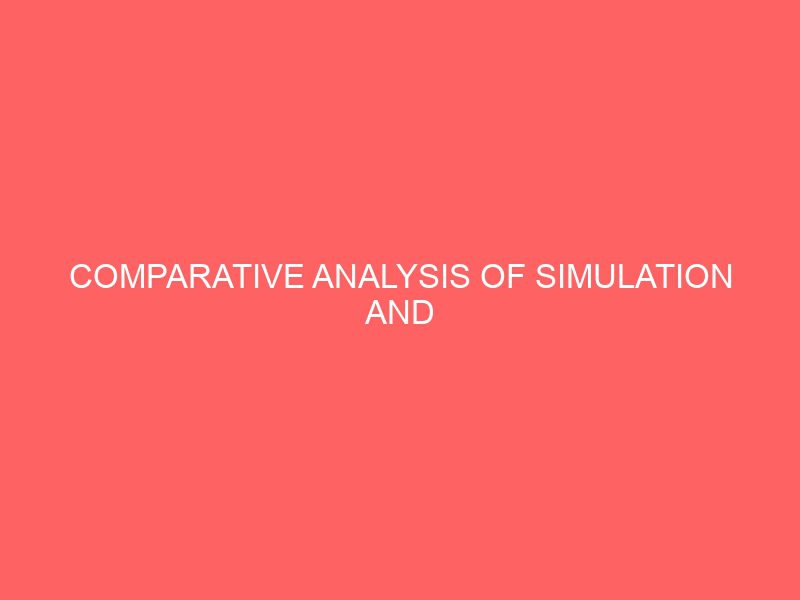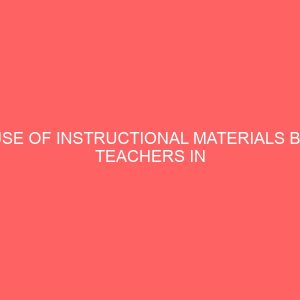Description
ABSTRACT
The study investigate and analyze the simulation and demonstrative method of on students academic achievement in basic technology in ogba egbema ndoni lga of rivers state, Nigeria. The design of the study was quasiexperimental with specifically the pretest and posttest. The sample of the study consisted of 159 senior secondary school I students 80 males and 79 females randomly selected from two schools out of the secondary schools in ogba egbema ndoni lga of rivers state, Nigeria. The experimental group comprised of 39 males and 39 females 78 students while the control had 41 males and 40 females 81 student. Four research questions and two hypotheses guided the study. The achievement test in simulation ATIS and achievement test in demonstration ATID was used to collect data on the student achievement. Means and standard deviation were used to answer the research questions while the ttest was used to test the hypotheses a 0.05 level of significance. The results showed that simulation increased students academic achievement in basic technology more than the demonstrative method. There was no significant different in the achievement of male and female students on the basic technology concepts. Based on the results it was recommended that basic technology teachers should be retrained on the use of simulation in teaching while the government and stake holders in Education should sponsor the purchase of simulators to be used in teaching basic technology in schools.
CHAPTER ONE
INTRODUCTION
1.1 BACKGROUND OF THE STUDY
There is a rapid development in the world today and every Nation strives to meet up with the requirement needed. She does so through science and technology. Science and technology education therefore became the factory that produces technologists, technicians, craftsmen and skilled artisans who are required to change the economy of any nation. Basic technological skills acquisition are necessary for nations to cope with the present today challenges.
Avaa 2007 pointed out that technology advancement can elevate Nigeria nation from a consumer to a producer and from developing to a developed nation. Ali 2001 defined technology as the successful application of scientific ideas, principles, laws and theories, for the purpose of developing techniques for and or providing goods and services. It is through technology that appliances such as computers, televisions, refrigerators, fan, vehicles, airplanes etc. are invented. Ali went furthers to state that science benefits technology while technology enhances the understanding of science. The contributions of science and technology to overall development of all nations cannot be emphasized. This is the reason science holds an important position in the curriculum of Nigerian educational system.
In Nigeria, science teaching and learning are emphasized in the National Policy on Education FME, 2008. In order to inculcate the necessary scientific knowledge, skills, competencies and attitudes in various development: strategies such as World Declaration on Education for Ail EFA are put in place in Nigeria educational system. Other strategies like the NEEDS National Economic Empowerment goals of MDGS Millennium Development Goals are put in place in orders to meet these goals. Nigeria began to update the existing curriculum to cater for the needs of the nation who is aspiring to be among the first 20 economist in the world by the year 2020. Basic technology education became the best avenue to meet the global challenges facing Nigerian Nation. Adesoji and Olatanbosun 2008 stated that it was as a result of the recognition given to basic technology in the development of the individual and the nation that it was made a coresubject among sciences and science related courses in Nigerian education system.
Basic technology is a course of study introduced in the year 2007 into the Primary and Junior Secondary School levels of the 934 system of education presently practiced in Nigeria. It is an amalgamation of many subjects. These subjects include; electrical/electronics, metal work, simple mechanics, wood work, technical drawing, food processing, rubber and plastic technology by the Federal Government of Nigeria 2009. However, the purposes of prevocational training given to students at the Primary and Junior Secondary School levels are: introduction into the world of technology towards interest arousal and choice of a vocation at the end of Junior Secondary School and professionalism later in life; exposing students to career awareness by exploring usable options in the world of work; and enabling youths to have an intelligent understanding of the increasing complexity of technology, Federal Republic of Nigeria, 2007 . As Comparative Education Study and Adaptation Center 2007 puts it, the objectives include:
To provide prevocational orientation for further training in technology.
To provide basic technology literacy for everyday living and
To stimulate creativity p. vii.
In order to achieve these objectives, the syllabus and the course books are structured and written in ways that would require the use of tools and equipment in appropriate environment. Such appropriate environment may be found especially in the laboratory or workshop.
Basic technology is an indispensable prevocational base on which future vocational choices are made. In their separate works, Ezeji S. C. 2004, Nwachukwu, C. E. 2006, Ogwo and Oranu, R. N. 2006 and Okoro O. M. 2006 all established that prevocational training requires same facilities and similar curriculum components as will be required in the real vocation, though at introductory levels. These components include; general education, theory and related courses, workshop practice, industrial training/production work, and small business management and entrepreneurial training.
The quality and quantity of practical experience gained by junior secondary school pupils in basic technology is predicated on the availability of facilities and the management of such facilities. Okoro O. M. 2006 pointed out that a good quality programme is housed in physical facilities which are adequate, well planned and properly directed to provide realistic education. UNESCO 2001 had stressed that for quality assurance in technological development to be achieved; responsible national authorities should establish criteria and standards, subject to periodic review and evaluation, to be applied to all aspects of technical and vocational education. Such criteria and standards should include physical facilities, buildings, libraries, workshop layout, quality and type of equipment, as well as safety measures meant to create a conducive learning environment. Such a recommendation requires planning of workshop facilities to enhance instructional activities and subsequent achievement of the objectives of setting up the programme.
Some author Olatoge and Atuwape 2004, Adesoji and Ogini 2012 blamed the poor achievement in basic technology to the poor academic background of students in Basic sciences taught at the Junior secondary schools classes JSS 13 level. The main aim of teaching is to transfer knowledge to the learners. For effective teaching and learning to take place, the teacher needs to use different methods and techniques in teaching. Unfortunately poor basic technology achievement has been attributed to poor teaching methods used by teachers Zimmerman in Nbina 2010, Angela and Ugwuegbulam 2011 and Rasari 2004. The present Nigeria basic technology classroom does not provide the fun, hands on, challenging, interactive and collaborative environment needed by new generation of students who have be exposed to internet, computer usage, handset and other sophisticated gargets. The problem of this nature can only be solved by the use of simulation.
Simulations are tools that facilitate learning through representation and practice in a repeatable, focused environment Aldrich 2004.
According to Goldsim 2011 simulation helps to identify and understand factors which control the system and or to predict the future behaviour of the system. Simulation programmes can be applied to chemistry by providing real life settings for the application of chemical concepts. Simulation includes role plays, games, computer programs that encourage students to become active participants in basic technology classroom. Simulation can be inferior substitute, imitating an original or a display of not real behaviours Simulations can be classified in many way:
Physical simulation: Here the physical object is presented on a screen and the students learn about it.
Process simulations: Processes that are not visible can be demonstrated using process simulations.
Procedural simulations: Here procedures as follows in order to understand sequence of events.
Situational Simulations: This has to do with attitudinal and behavioural changes of people. The students use this simulation to explore the effects of different approaches to a problem. Tippler, 2003
Simulation has three types namely:
Live Simulation: This shows human behaviour in real life. Examples is training of soldiers in war games.
Virtual simulations: Simulation occurs in a computer controlled setting. For example a pilot flying and air craft but is controlled from the control room.
Constructive simulations: This does not involve humans or equipment but by proper sequencing of events. For example weather changes like wind directions. Institute of Simulation and Training IST University of Florida 2002.
In this thesis life simulation will be used since humans student are involved. Simulation in teaching and learning of basic technology helps understanding of abstract and difficult concepts by allowing the students to experiment on the variables that form the concept than demonstration. Computer simulation helps students to develop their own understanding of basic technology concepts over demonstrations. It also helps the students to be independent problem solvers. Chen and Howard 2010 observed that the use of simulations to teach basic technology gives positive results over demonstration time. It is important to determine whether male and female students will benefit equally with the use of simulation in teaching basic technology.
Gender is any physical and behavioural difference between males and females which are social culturally based, Okeke 2008, Ezeh 2013. Ogunleye and Babajide 2011 observed that science subjects such as basic technology are given masculine outlook by many educationists. That means that women and girls grapple with a lot of discriminations and difficulties Okeke, 2008. Applying feminist theory in Science Education which stated that by changing the science curriculum and how science is taught with make a significant change on women participation in science. This study will then see the influence of simulation in students achievement in senior secondary school basic technology.
Many theorists had advocated for active participation of the learner in the learning process. Vygotsky 1978 emphasized on social interaction as the best ways of learning. To him a child learns better in collaborative activities than when he/she learns alone. Vygosky social theory is applied in this study since simulation involves role plays and computer programs that encourage students to become active participants in the application of basic technology concepts. Students are able to learn better when they have social interaction among themselves and the relevant learning resources. Simulation provides cooperative work skills and cognitive apprenticeship needed in the study of basic technology. The teacher provides simulated experiences which helps in demonstrating concepts to students and makes for the students understanding of the concepts. Many researchers had used simulation successfully.
1.2 STATEMENT OF THE PROBLEM
In the year 2007, the Universal Basic Education scheme introduced basic technology to replace introductory technology, with a desire to achieve what could not be realized through introductory technology. Same teachers of introductory technology and other workshop staff are used to implement basic technology. Workshops used for introductory technology are still being used for basic technology. According to Toby, 2000, students cannot learn skills of their chosen occupation at maximum efficiency with poor and obsolete equipment, neither will the students develop positive attitudes towards the use of tools and equipment of their trade if the laboratories/workshops are not properly managed and facilities inadequately maintained. Therefore the problem of this study, is to compare and analyze simulation and demonstration methods on students academic achievements in basic technology in ogba egbema ndoni lga of rivers state, and put in question, is How will basic technology workshops be learn to improve the student academic achievement in the secondary schools in Nigeria
1.3 PURPOSE OF THE STUDY
The general purpose of the study is to analyze by comparing the two dependent variable simulation and demonstration methods of teaching on students
its academic achievement in basic technology. Specifically, the study seeks to:
1. Analyze the difference in academic achievement of students taught basic technology using simulation method with those taught using demonstration method.
2. Determine the difference in the pretest and posttest mean scores of students after being taught basic technology with simulation method of teaching.
3. Determine the difference in the pretest and posttest mean scores of students after being taught basic technology with demonstration method of teaching.
4. Find out the means learning the students appreciate more with understanding.
1.4 SIGNIFICANCE OF THE STUDY
This thesis is significant in various ways to various sectors, as will be seen below; it will present in a precise manner, the importance of the simulation and demonstration methods in learning. It is believed that the findings of this research work should provide detailed information on the use of simulation and demonstration methods in obtaining a high student achievements and performance. It is also expected that the study will benefit teachers, basic technology students, researchers and the society in general.
The findings of the study should be useful to teachers. It is expected that the findings will expose the basic technology teachers to the importance of using the various informal and innovative instructional methods such as the simulation method which is more of student centered and commercially driven. By this exposure the teachers could acknowledge the advantage over the traditional teaching methods such as demonstration, which is teacher centered. It is possible that by this outcome the basic technology teachers would realistically adjust to the application of simulation method of teaching for effective instruction. In turn, the students would have real focus for better performance and achievements in their studies.
Subsequently, it will go a long way to enhance the basic technology students effectiveness in the society by being capable of carrying out what they have learned, thereby contributing to the building up of the society at the local, national and international levels.
The research will also be beneficial to the researcher. This is because the study will expose the researcher to so many related areas in the course of carrying out his research. This will enhance the researchers experience, knowledge and understanding on simulation and demonstration methods in learning.
1.5 SCOPE OF THE STUDY
This thesis will cover the simulation method of teaching, its academic achievements on students, demonstration teaching method, equally with its academic achievements on the students, a comparative analysis of both means and effects of gender on student achievements in basic technology studies. The Study concentrate on areas of design and construction of gadget that offer both theoretical and practical experience to the students. The study will be restricted to only schools junior secondary school where basic technology are taught in ogba egbema ndoni lga of rivers state.
1.6RESEARCH QUESTIONS
For a better understanding and comprehension of this research thesis, in carrying out this study effectively, the following research questions guided the study.
What is the difference in academic achievement of students taught basic technology with simulation method and those taught with demonstration method
What is the effect of simulation on students academic achievement in junior secondary school basic technology
Is there any differential effect of simulation on male and female students achievement in basic technology
What is the difference in the pretest and posttest mean scores of the students after being exposed to simulation method of teaching basic technology
What is the difference in the pretest and posttest mean scores of the students after being exposed to demonstration method of teaching basic technology
1.7 RESEARCH HYPOTHESIS
The researcher formed some of the hypothesis which will be tested to support this study. The hypothesis will be tested at 0.05 level of significance.
The research hypothesis are as follows.
1: There is no significant difference between the mean achievement of students taught basic technology with simulation and those taught using the conventional methods.
2: There is no significant difference between the mean achievement of male and female students in Achievement Test in Simulation ATIS.
REFERENCE
Asiabaka, I. P. 2008. The Need for Effective Facility Management in Schools in Nigeria. New York: Science Journal 12: 1021.
Babu, A. R.; Singh V. P. and Sachdeva, R. K. 1997. Establishing a Management Information Systems. In B.E. Swanson et al Eds. Improving Agricultural Extension, 108 134. A Reference Manual Rome: FAO.
Comparative Education Study and Adaptation Center 2007. Introductory Technology for Junior Secondary Schools: Ikeja, Lagos: Longman.
Comparative Education Study and Adaptation Center 2007. Introductory Technology for Junior Secondary Schools: Ikeja, Lagos: Longman
Dror, Y. 1967. The Planning Process: A Facet Design in Planning, Programming and Budgeting. In F.G. Lyden and E.G. Mitter eds. A System Approach to Management pp.91101. Chicago: Markham Publishing Company.
Esomonu, N. P. M. 2002. Analysis of Inadequate Infrastructure in Technology Education: Focus on Workshop/Laboratory Practice. Journal of Technical Education, Research and Development 1 1: 2431.
Ezeji S. C. O. A. 2004. A Guide to Preparing Educational Specifications for Secondary Industrial Arts Facilities. Enugu: Cheston Agency.
Federal Government of Nigeria 2009. Basic Technology for Schools. Lagos: Comparative Education Study and Adaptation Centre
Fakomogbon, M. A. 2004. The Laboratory in Introductory Technology: Some Basic Considerations and Needs. Nigerian Journal of Education 31: 3846
Federal Ministry of Education 2007. 9 Year Basic Education Curriculum; Basic Technology for JS 13. Abuja: Nigeria Education Research and Development Council.
Federal Government of Nigeria 2009. Basic Technology for Schools. Lagos: Comparative Education Study and Adaptation Centre.
Fenker, O. M. 2004. Organizational Change, Representations and Facilities. In K. Alexander Ed. Facilities Management; Innovation and Performance. U.K: Taylor Francis.
Nwachukwu, C. E. 2006. Designing Appropriate Methodology in Vocational and Technical Education for Nigeria. Nsukka: University Trust Publishers.
Ogwo, B. A. and Oranu, R. N. 2006. Methodology in Formal and Non Formal Technical/Vocational Education. Nsukka: University of Nigeria Press.
Okoro, O. M. 2006. Principles and Methods in Vocational and Technical Education. Nsukka: University Trust Publishers.
T. U. 2000. Essentials of Management and Leadership in Vocational and Technical Education 2nd Edition. Jos: Nigerian Association of Technology Teachers.
UNESCO 2001. Instruments Concerning the Institutional Framework for Training: Revised Recommendations Concerning Technical and Vocational Education. Retrieved on June 18, 2010 fromhttp://www.lagosnet.net/ilo/150base/en/tropici/tizuries.htm.








Reviews
There are no reviews yet.